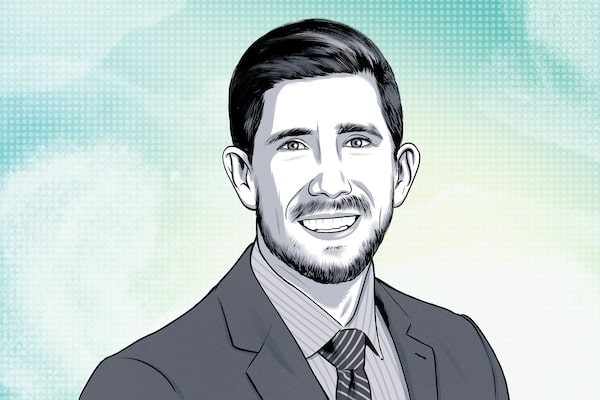
Rodrigo Gordillo.The Globe and Mail
Few investors have experienced the devastating impacts of inflation like asset manager Rodrigo Gordillo, who grew up in Peru during the country’s “lost decade.”
His family’s savings, held in a Peruvian bank, were wiped out when inflation skyrocketed 7,000 per cent in 1988, followed by a deflationary bust that led them to immigrate to Canada to start a new life when he was 8.
The experience eventually led Mr. Gordillo to pursue a career in finance, with a focus on inflationary effects that had been an afterthought for many investors, until recently.
“My formative years meant I’ve kept my eye on the ball … and it’s certainly paying off now,” says Mr. Gordillo, president and portfolio manager at ReSolve Asset Management. “Investors need to look outside their borders, to people who have struggled through inflation, to truly understand how impactful that can be to their purchasing power.”
The personal experience also led Mr. Gordillo, who oversees about $600-million in assets, to diversify globally across all major asset classes, including equities, bonds, currencies and commodities, and allocate to long and short strategies.
“We run what we like to call an ‘all terrain portfolio’ that’s designed to thrive during bull markets, bear markets and inflationary regimes,” he says.
His firm’s flagship strategy is the $125-million ReSolve Evolution Multi Strategy Future Program, which trades global equity indexes, bond indexes, commodities and currencies via futures contracts both long and short. The fund has returned 27 per cent over the past year, as of Aug. 31. The firm also sub-advises the Horizons ReSolve Adaptive Asset Allocation ETF HRAA-T, which has seen a total return of about 4 per cent over the past year as of Sept. 6.
The Globe and Mail recently spoke to Mr. Gordillo about what he’s been buying and selling, and the financial advice he gives friends and family:
What’s your take on the current market environment?
We believe we’re in an inflation volatility decade, which is something we haven’t seen in decades. Consider that, from 1926 to 1989, the annualized volatility of inflation was 4.8 per cent, which is 3.5 times more volatile than that we have experienced from 1990 to 2020. From 1989 to 2021, it was 1.3 per cent annualized. In that benign inflation environment, equities and bonds thrive. But things have changed this year; we will have to contend with inflation volatility, which can mean equities and bonds correlate, often losing money at the same time – which we saw earlier this year. It’s a new experience for many investors, especially those newer to investing. Those who say, “I can’t wait for the market to get back to normal,” could be in for a rude awakening. We believe that traditional equity-bond portfolios need to be positioned to reduce losses and that adding alternatives can help.
What are you buying, or where are you ‘long’ in your case?
Our standout position over the past year has been in energy via futures contracts. We’ve gone from a 25-per-cent position through much of the first quarter to near zero in late July, and back to 25 per cent recently. It’s our biggest position right now. We look at momentum, seasonal patterns and relative value – all of which signal energy doing well in the coming days, despite the recent correction. Things are also going on in the background to suggest the energy trade isn’t over, especially as we’re going into the cold season and given the concerns in Europe about whether people will have enough gas to heat their homes. I don’t think that’s being priced into the markets right now. We have also been active in metals. After shorting them in March, we are adding to – or long – our positions in copper, palladium and platinum. We’re also adding to fixed income again, specifically global government bonds.
What are you shorting?
We have been short the Canadian dollar and most foreign currencies and long the U.S. dollar. The U.S. dollar has been strengthening as the Federal Reserve has been more aggressive in raising rates relative to Europe and Japan. While the Bank of Canada has been more aggressive on rates, and strong energy prices typically bolster the loonie, currency markets are concerned about a hard economic landing in Canada. We have also been short grains, including wheat, canola and palm oil. The narrative has been around supply issues due to the Ukraine crisis and rising inflation and food costs, but that peaked a few months ago.
What investing advice do you give family members when they ask?
Diversity and balance are key to investing. Too often, people think diversity is buying 40 equities in the Canadian market. That’s just one bet. You need to diversify into bonds, and into commodities, in case both equities and bonds go down together. You also need to diversify globally across asset classes. Having the right balance of assets is also important: For instance, you can’t allocate a third of your dollars to commodities because they have three times the volatility of the bonds. I also recommend people create a set of investing rules for themselves. Write them down and stick to them.
Do you discuss inflation with your family, given your experience in Peru?
The conversation has never stopped. It happens at every family gathering; every conversation is about that period and its lasting impact on people’s standard of living. It’s why the concept of cash being “safe” has always been anathema to me. In my experience, no asset class is safe.
This interview has been edited and condensed.